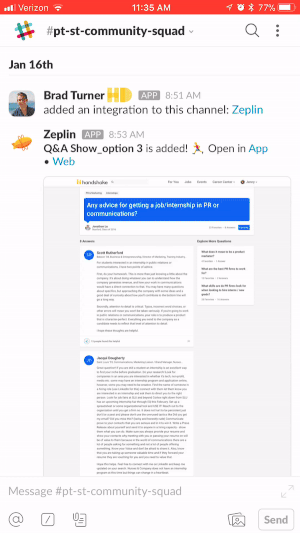Get your designs roasted in the open
This article was initially published on Handshake’s design blog
“Your designs are getting lit up…”
A few weeks ago, as I was walking into a meeting, Spencer, one of our engineers, mentioned that my designs were getting “LIT UP in our team’s Slack channel.”
It took me a second to process what he was saying. “Lit up…?” 🤔 “Wait, what? Were they bad?… Were people ripping them apart?”
I braced myself and opened up Slack to take a look.
After scrolling through the first few comments, I chuckled a bit. Let’s just say I had nothing to be worried about: my designs getting “lit up” was nothing out of the ordinary…
Collaborating in the open
It turns out our team Slack channel was being flooded with feedback from members of our Design Team through a Zeplin integration. For each of their comments, a message flowed into the public channel for the engineers, product manager, and other members of the team to see. To Spencer, this felt like a lot of feedback. To me, this wasn’t surprising at all. As a Design Team, we actively ask for feedback like this.

What Spencer interpreted as my work getting ripped apart was actually an inside look at one of the ways that we collaborate and help each other grow.
But, should we be doing this in the open?
While this experience may seem insignificant, it provoked an interesting conversation within the Design Team. Should we put all of this in the open? Should we restrict these conversations to designers only? Is putting all of this feedback in a public channel distracting or beneficial?

Consider context
The shortest answer we could come up with about whether or not we should share designs and feedback out in the open for anyone to see is….
“It depends…”
This specific way of providing feedback has two particularly interesting characteristics.
It’s asynchronous 🙋🏾🙋🏼
The Zeplin-Slack integration resulted in a stream of thoughts condensed into a few snippets of text, left up for interpretation by the reader, and not demanding an immediate response.
Text-based asynchronous feedback like this can lack emotion. Design needs to be empathetic. The best designers are empathetic individuals who care just as much about how something is being said as what is being said. Some conversations are better in person, where comments are less likely to be misinterpreted and, if they are misinterpreted, there’s opportunities to immediately ask clarifying questions.
It’s public 📣
Anyone in the company can see what we’re working on, interpret comments in their own way, and leave their own comments and questions. Public feedback isn’t always the right solution. Sometimes we designers need the space to discuss our designs without getting into the concerns from others around how a certain design might drive metrics, or hashing out specific implementation details. Of course, we do have these conversations throughout the design process, but we choose to have them at the right time. “Right now” is not always the right time.

Build it into your process
With these two characteristics in mind, we looked at how we’ve incorporated avenues for feedback into our design process.
To meet, or not to meet 🗓
Zeplin is great for asynchronous feedback. If there isn’t a need for a meeting for that round of feedback, we save time by not having to coordinate schedules to receive feedback. We can just upload our designs and send a link to whomever we’re requesting feedback from.
For the feedback conversations that are better in-person, we have a weekly Design Team meeting. This weekly cadence may be too often for everyone to get together, or maybe we don’t need everyone on the team, but it’s still great to have in-person feedback time available when needed!
Out in the open 🏕
We encourage you to try soliciting feedback from everyone involved in the project out in the open — for us that includes linking up the Zeplin project with the team’s Slack channel. Even when collecting feedback in person, try collecting the feedback somewhere that everyone on your team can see.
We’ve found this provides transparency into the many sources of feedback you may navigate to take a design from inception to a version that’s ready for implementation. No more re-explaining all the feedback you’ve received to the Product Manager you’re partnering with or circulating open questions that still need to be answered.

Embrace your designs getting “lit up”
At Handshake, we don’t design in isolation. Collaboration and transparency have helped us build great relationships with teammates across the company and level up our designs, making it easier for millions of college students to find their first jobs and build a great career.
While it’s perfectly normal to want to keep your designs private until you’ve got all the details worked out, we encourage you to challenge yourself to put them out in the open early. As a Design Team, set an example for the rest of the company about what great feedback looks like by putting that process in the open, too.

